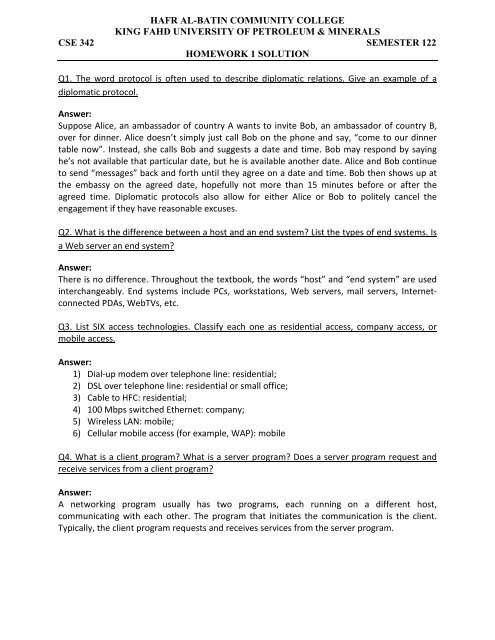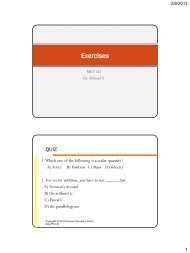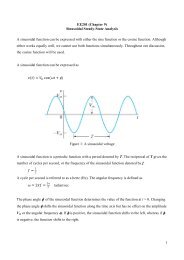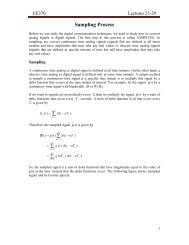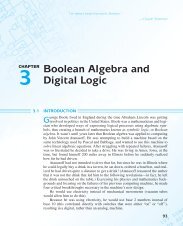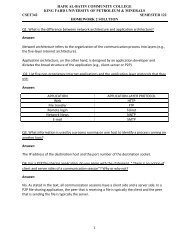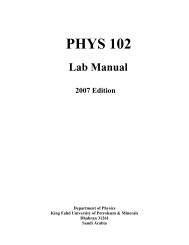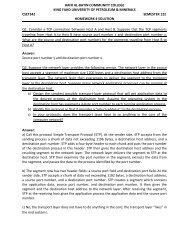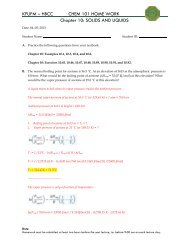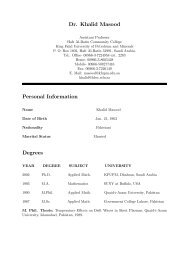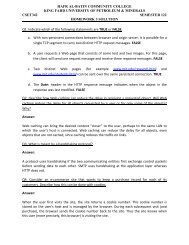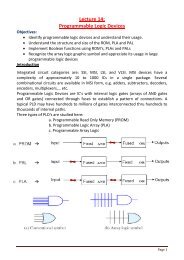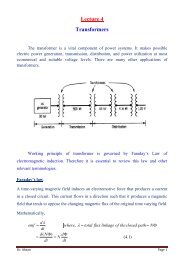Homework 1 Solution - Hafr Al-Batin Community College(HBCC)
Homework 1 Solution - Hafr Al-Batin Community College(HBCC)
Homework 1 Solution - Hafr Al-Batin Community College(HBCC)
You also want an ePaper? Increase the reach of your titles
YUMPU automatically turns print PDFs into web optimized ePapers that Google loves.
HAFR AL-BATIN COMMUNITY COLLEGE<br />
KING FAHD UNIVERSITY OF PETROLEUM & MINERALS<br />
CSE 342 SEMESTER 122<br />
HOMEWORK 1 SOLUTION<br />
Q1. The word protocol is often used to describe diplomatic relations. Give an example of a<br />
diplomatic protocol.<br />
Answer:<br />
Suppose <strong>Al</strong>ice, an ambassador of country A wants to invite Bob, an ambassador of country B,<br />
over for dinner. <strong>Al</strong>ice doesn’t simply just call Bob on the phone and say, “come to our dinner<br />
table now”. Instead, she calls Bob and suggests a date and time. Bob may respond by saying<br />
he’s not available that particular date, but he is available another date. <strong>Al</strong>ice and Bob continue<br />
to send “messages” back and forth until they agree on a date and time. Bob then shows up at<br />
the embassy on the agreed date, hopefully not more than 15 minutes before or after the<br />
agreed time. Diplomatic protocols also allow for either <strong>Al</strong>ice or Bob to politely cancel the<br />
engagement if they have reasonable excuses.<br />
Q2. What is the difference between a host and an end system? List the types of end systems. Is<br />
a Web server an end system?<br />
Answer:<br />
There is no difference. Throughout the textbook, the words “host” and “end system” are used<br />
interchangeably. End systems include PCs, workstations, Web servers, mail servers, Internetconnected<br />
PDAs, WebTVs, etc.<br />
Q3. List SIX access technologies. Classify each one as residential access, company access, or<br />
mobile access.<br />
Answer:<br />
1) Dial-up modem over telephone line: residential;<br />
2) DSL over telephone line: residential or small office;<br />
3) Cable to HFC: residential;<br />
4) 100 Mbps switched Ethernet: company;<br />
5) Wireless LAN: mobile;<br />
6) Cellular mobile access (for example, WAP): mobile<br />
Q4. What is a client program? What is a server program? Does a server program request and<br />
receive services from a client program?<br />
Answer:<br />
A networking program usually has two programs, each running on a different host,<br />
communicating with each other. The program that initiates the communication is the client.<br />
Typically, the client program requests and receives services from the server program.
Q5. List the available residential access technologies in your city.<br />
Answer:<br />
Current possibilities include: dial-up; DSL;<br />
Q6. What are some of the physical media that Ethernet can run over?<br />
Answer:<br />
Ethernet most commonly runs over twisted-pair copper wire and “thin” coaxial cable. It also<br />
can run over fibers optic links and thick coaxial cable.<br />
Q7. Is HFC transmission rate dedicated or shared among users? Are collisions possible in a<br />
downstream HFC channel? Why or why not?<br />
Answer:<br />
HFC bandwidth is shared among the users. On the downstream channel, all packets emanate<br />
from a single source, namely, the head end. Thus, there are no collisions in the downstream<br />
channel.<br />
Q8. Describe the most popular wireless Internet access technologies today. Compare and<br />
contrast them.<br />
Answer:<br />
There are two most popular wireless Internet access technologies today:<br />
• Wireless LAN<br />
In a wireless LAN, wireless users transmit/receive packets to/from a base station (wireless<br />
access point) within a radius of few tens of meters. The base station is typically connected<br />
to the wired Internet and thus serves to connect wireless users to the wired network.<br />
• Wide-area wireless access network<br />
In these systems, packets are transmitted over the same wireless infrastructure used for<br />
cellular telephony, with the base station thus being managed by a telecommunications<br />
provider. This provides wireless access to users within a radius of tens of kilometers of the<br />
base station.<br />
Q9. Dial-up modems, HFC, and DSL are all used for residential access. For each of these<br />
technologies, provide a range of transmission rates and comment on whether the transmission<br />
rate is shared or dedicated.<br />
Answer:<br />
Dial up modems: up to 56 Kbps, bandwidth is dedicated; ISDN: up to 128 kbps, bandwidth is<br />
dedicated; ADSL: downstream channel is .5-8 Mbps, upstream channel is up to 1 Mbps,<br />
bandwidth is dedicated; HFC, downstream channel is 10-30 Mbps and upstream channel is<br />
usually less than a few Mbps, bandwidth is shared. FTTH: 2-10Mbps upload; 10-20 Mbps<br />
download; bandwidth is not shared.
Q10. What is the transmission rate of Ethernet LANS? For a given transmission rate, can each<br />
user on the LAN continuously transmit at that rate?<br />
Answer:<br />
Ethernet LANs have transmission rates of 10 Mbps, 100 Mbps, 1 Gbps and 10 Gbps. For an X<br />
Mbps Ethernet (where X = 10, 100, 1,000 or 10,000), a user can continuously transmit at the<br />
rate X Mbps if that user is the only person sending data. If there are more than one active user,<br />
then each user cannot continuously transmit at X Mbps.<br />
Q11. Suppose there is exactly one packet switch between a sending host and a receiving host.<br />
The transmission rates between the sending host and the switch and between the switch and<br />
the receiving hosts are R 1 and R 2 , respectively. Assuming that the switch uses store-andforward<br />
packet switching, what is the total end-to-end delay to send a packet of length L?<br />
(Ignore queuing delay, propagation delay, and processing delay.)<br />
Answer:<br />
At time t0 the sending host begins to transmit. At time t1 = L/R1, the sending host completes<br />
transmission and the entire packet is received at the router (no propagation delay). Because<br />
the router has the entire packet at time t1, it can begin to transmit the packet to the receiving<br />
host at time t1. At time t2 = t1 + L/R2, the router completes transmission and the entire packet<br />
is received at the receiving host (again, no propagation delay). Thus, the end-to-end delay is<br />
L/R1 + L/R2.<br />
Q12. What advantage does a circuit-switched network have over a packet-switched network?<br />
What advantage does TDM have over FDM in a circuit-switched network?<br />
Answer:<br />
A circuit-switched network can guarantee a certain amount of end-to-end bandwidth for the<br />
duration of a call. Most packet-switched networks today (including the Internet) cannot make<br />
any end-to-end guarantees for bandwidth.<br />
Q13. What is the key distinguishing difference between a tier-1 ISP and a tier-2 ISP?<br />
Answer:<br />
A tier-1 ISP connects to all other tier-1 ISPs; a tier-2 ISP connects to only a few of the tier-1 ISPs.<br />
<strong>Al</strong>so, a tier-2 ISP is a customer of one or more tier-1.<br />
Q14. Suppose users share a 2 Mbps link. <strong>Al</strong>so suppose each user transmits continuously at 1<br />
Mbps when transmitting, but each user transmits only 20 percent of the time.<br />
a.<br />
b.<br />
When circuit switching is used, how many users can be supported?<br />
For the remainder of the problem suppose packet switching is used. Why will there be<br />
essentially no queuing delay before the link if two or fewer users transmit at the same<br />
time? Why will there be a queuing delay if three users transmit at the same time?
c.<br />
d.<br />
Find the probability that a given user is transmitting.<br />
Suppose now there are three users. Find the probability that at any given time, all three<br />
users are transmitting simultaneously. Find the fraction of time during which the queue<br />
grows.<br />
Answer:<br />
a. 2 users can be supported because each user requires half of the link bandwidth.<br />
b. Since each user requires 1 Mbps when transmitting, if two or fewer users transmit<br />
simultaneously, a maximum of 2Mbps will be required. Since the available bandwidth of the<br />
shared link is 2Mbps, there will be no queuing delay before the link. Whereas, if three users<br />
transmit simultaneously, the bandwidth required will be 3Mbps which is more than the<br />
available bandwidth of the shared link. In this case, there will be queuing delay before the<br />
link.<br />
c. Probability that a given user is transmitting = 0.2<br />
⎛3⎞<br />
d. Probability that all three users are transmitting simultaneously = ⎜ ⎟ p<br />
3<br />
(1-p) 3-3 = (0.2) 3 =<br />
⎝3⎠<br />
0.008. Since the queue grows when all the users are transmitting, the fraction of time<br />
during which the queue grows (which is equal to the probability that all three users are<br />
transmitting simultaneously) is 0.008.<br />
Q15. Why is it said that packet switching employs statistical multiplexing? Contrast statistical<br />
multiplexing with the multiplexing that takes place in TDM.<br />
Answer:<br />
In a packet switched network, the packets from different sources flowing on a link do not follow<br />
any fixed, pre-defined pattern. In TDM circuit switching, each host gets the same slot in a<br />
revolving TDM frame.


